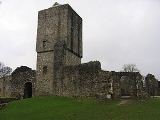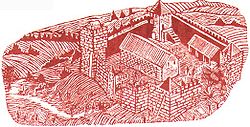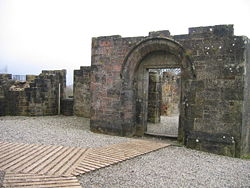
Mugdock Castle
Encyclopedia
Mugdock Castle was the stronghold of the Clan Graham
from the middle of the 13th century. Its ruins are located in Mugdock Country Park
, just west of the village of Mugdock in the parish of Strathblane
. The castle is within the registration county of Stirlingshire
, although it is only 2 km north of Milngavie
, East Dunbartonshire
, on the northern outskirts of Greater Glasgow
.
. It is possible that his descendant, Sir David de Graham (d. 1396) built the castle. It was certainly standing by August 1372, when a contemporary document was signed here. In 1458, the lands were erected into the Barony of Mugdock. Later, in 1505, the Grahams were created Earls of Montrose
.
The most famous of the Montrose Grahams, James Graham, 1st Marquess of Montrose
, may have been born at Mugdock Castle in 1612. During the Bishops Wars, a prelude to the Wars of the Three Kingdoms, Montrose briefly supported the Covenanters. Montrose was imprisoned in Edinburgh in 1641, for intrigues against Archibald Campbell, 1st Marquess of Argyll
, who was to become his arch-enemy. While Montrose was in prison, Lord Sinclair
sacked Mugdock. Montrose returned there, however, until 1644 when he began his Royalist revolt, becoming the King's commander in Scotland. Mugdock was sacked again that year.
Following the defeat of Charles I
, Montrose was executed in 1650, and the lands were forfeited to the Marquess of Argyll. In 1661 Argyll too was executed, and Mugdock was returned to the Grahams, who restored the castle over a two year period, building a mansion within the old castle walls. In 1682 the Grahams bought Buchanan Old House
near Drymen, a dwelling more fitting the title of "Marquess". The family's official seat was kept at Mugdock Castle for a some time.
A terraced walled garden, incorporating a summer house, was built to the east of the castle in the 1820s. In 1875, the 17th century mansion was demolished, and a Scottish baronial style
house was built in the ruins of the old castle. It was designed by architect James Sellers for local historian and antiquarian James Guthrie Smith. Much of the eastern part of the original castle was destroyed in the process. During World War II
the house was requisitioned for use by the government, but by 1948 was empty. It was demolished in 1967, although foundations and walls remain.
In 1981 the castle and grounds were donated by its then owner to Central Regional Council. The lands now form part of Mugdock Country Park, and the ruins are publicly accessible. The remaining tower has been renovated as a museum. The castle is a Scheduled Ancient Monument
and a Category A listed building.
 The original castle was built in the mid-14th century. It comprised four towers arranged around a courtyard, and linked by high curtain walls. In the middle of the south wall was the main gate. The castle stood on a natural, steep-sided mound formed of hard volcanic rock, at the west edge of Mugdock Loch, which was larger than its present extent. Of the early castle, only the south-west tower remains complete, and forms the most recognisable feature of the ruins. The narrow tower is of four storeys, with an entrance on the first floor, accessed via exterior steps on the east side. Inside the basement is vaulted, and a single room occupies each storey. On the outside, a line of corbels projects the two upper storeys out from the lower levels, giving the tower a distinctive "top-heavy" appearance. The only other remains are the basement of the north-west tower, part of the gatehouse, and linking sections of curtain wall.
The original castle was built in the mid-14th century. It comprised four towers arranged around a courtyard, and linked by high curtain walls. In the middle of the south wall was the main gate. The castle stood on a natural, steep-sided mound formed of hard volcanic rock, at the west edge of Mugdock Loch, which was larger than its present extent. Of the early castle, only the south-west tower remains complete, and forms the most recognisable feature of the ruins. The narrow tower is of four storeys, with an entrance on the first floor, accessed via exterior steps on the east side. Inside the basement is vaulted, and a single room occupies each storey. On the outside, a line of corbels projects the two upper storeys out from the lower levels, giving the tower a distinctive "top-heavy" appearance. The only other remains are the basement of the north-west tower, part of the gatehouse, and linking sections of curtain wall.
 By the late 19th century, much of the castle was in ruins. When James Guthrie Smith built his mansion, any remains of the eastern towers were obliterated. The one surviving tower was incorporated into the new building, via a first-floor covered passage, over a wide-arched bridge. The house itself was L-shaped and three storeys high, and built in the Scottish baronial style
By the late 19th century, much of the castle was in ruins. When James Guthrie Smith built his mansion, any remains of the eastern towers were obliterated. The one surviving tower was incorporated into the new building, via a first-floor covered passage, over a wide-arched bridge. The house itself was L-shaped and three storeys high, and built in the Scottish baronial style
. The front door faced the south-west tower, framing a small courtyard. The house was mostly demolished to the foundations in 1967, although some walls stand to first-floor level.
Guthrie Smith was a relative of James Smith of Jordanhill, 4th Laird of Craigend
. The Smith family were retainers of the Clan Graham.
Clan Graham
Clan Graham is a Scottish clan who had territories in both the Scottish Highlands and Lowlands.-Origins:Legend has it that the first Graham was one Gramus who forced a breach in the Roman Antonine wall known as Graeme's Dyke in 420 A.D...
from the middle of the 13th century. Its ruins are located in Mugdock Country Park
Mugdock Country Park
Mugdock Country Park is a country park and historical site located partly in East Dunbartonshire and partly in Stirling, in the former county of Stirlingshire, Scotland...
, just west of the village of Mugdock in the parish of Strathblane
Strathblane
Strathblane is a village and parish in the registration county of Stirlingshire, situated in the southwestern part of the Stirling council area, in central Scotland. It lies at the foothills of the Campsie Fells and the Kilpatrick Hills on the Blane Water, north of Glasgow, east-southeast of...
. The castle is within the registration county of Stirlingshire
Stirlingshire
Stirlingshire or the County of Stirling is a registration county of Scotland, based around Stirling, the former county town. It borders Perthshire to the north, Clackmannanshire and West Lothian to the east, Lanarkshire to the south, and Dunbartonshire to the south-west.Until 1975 it was a county...
, although it is only 2 km north of Milngavie
Milngavie
Milngavie , is a town in East Dunbartonshire, Scotland. It is on the Allander Water, at the northwestern edge of Greater Glasgow, and about from Glasgow city centre. It neighbours Bearsden....
, East Dunbartonshire
East Dunbartonshire
This article is about the East Dunbartonshire council area of Scotland. See also East Dunbartonshire .East Dunbartonshire is one of the 32 council areas of Scotland. It borders onto the north-west of the City of Glasgow. It contains many of the suburbs of Glasgow as well as containing many of...
, on the northern outskirts of Greater Glasgow
Greater Glasgow
Greater Glasgow is an urban settlement in Scotland consisting of all localities which are physically attached to the city of Glasgow, forming with it a single contiguous urban area...
.
History
The lands of Mugdock were a property of the Grahams from the mid-13th century, when David de Graham of Dundaff acquired them from the Earl of LennoxMaol Domhnaich, Earl of Lennox
Mormaer Maol Domhnaich was the son of Mormaer Ailín II, and ruled Lennox 1217–1250.Like his predecessor Ailín II, he showed absolutely no interest in extending an inviting hand to oncoming French or English settlers...
. It is possible that his descendant, Sir David de Graham (d. 1396) built the castle. It was certainly standing by August 1372, when a contemporary document was signed here. In 1458, the lands were erected into the Barony of Mugdock. Later, in 1505, the Grahams were created Earls of Montrose
Duke of Montrose
The title of Duke of Montrose was created twice in the peerage of Scotland, firstly in 1488 for David Lindsay, 5th Earl of Crawford. It was forfeited and then returned, but only for the period of the holder's lifetime...
.
The most famous of the Montrose Grahams, James Graham, 1st Marquess of Montrose
James Graham, 1st Marquess of Montrose
James Graham, 1st Marquess of Montrose was a Scottish nobleman and soldier, who initially joined the Covenanters in the Wars of the Three Kingdoms, but subsequently supported King Charles I as the English Civil War developed...
, may have been born at Mugdock Castle in 1612. During the Bishops Wars, a prelude to the Wars of the Three Kingdoms, Montrose briefly supported the Covenanters. Montrose was imprisoned in Edinburgh in 1641, for intrigues against Archibald Campbell, 1st Marquess of Argyll
Archibald Campbell, 1st Marquess of Argyll
Archibald Campbell, 1st Marquess of Argyll, 8th Earl of Argyll, chief of Clan Campbell, was the de facto head of government in Scotland during most of the conflict known as the Wars of the Three Kingdoms, also known as the British Civil War...
, who was to become his arch-enemy. While Montrose was in prison, Lord Sinclair
Lord Sinclair
Lord Sinclair is a title in the Peerage of Scotland. It was created in 1449 for William Sinclair, 3rd Earl of Orkney. In 1470, Lord Orkney surrendered the earldom in return for the earldom of Caithness. In 1477, Lord Caithness wished to disinherit his eldest son from his first marriage to Lady...
sacked Mugdock. Montrose returned there, however, until 1644 when he began his Royalist revolt, becoming the King's commander in Scotland. Mugdock was sacked again that year.
Following the defeat of Charles I
Charles I of England
Charles I was King of England, King of Scotland, and King of Ireland from 27 March 1625 until his execution in 1649. Charles engaged in a struggle for power with the Parliament of England, attempting to obtain royal revenue whilst Parliament sought to curb his Royal prerogative which Charles...
, Montrose was executed in 1650, and the lands were forfeited to the Marquess of Argyll. In 1661 Argyll too was executed, and Mugdock was returned to the Grahams, who restored the castle over a two year period, building a mansion within the old castle walls. In 1682 the Grahams bought Buchanan Old House
Buchanan Castle
Buchanan Castle is a large house in Stirlingshire, Scotland, and serves today as the seat of the Clan Graham.Located west of the village of Drymen, the house was built by the 4th Duke of Montrose in 1854. The original structure, the ancestral seat of the Clan Buchanan, had burned down in 1852, and...
near Drymen, a dwelling more fitting the title of "Marquess". The family's official seat was kept at Mugdock Castle for a some time.
A terraced walled garden, incorporating a summer house, was built to the east of the castle in the 1820s. In 1875, the 17th century mansion was demolished, and a Scottish baronial style
Scottish baronial style
The Scottish Baronial style is part of the Gothic Revival architecture style, using stylistic elements and forms from castles, tower houses and mansions of the Gothic architecture period in Scotland, such as Craigievar Castle and Newark Castle, Port Glasgow. The revival style was popular from the...
house was built in the ruins of the old castle. It was designed by architect James Sellers for local historian and antiquarian James Guthrie Smith. Much of the eastern part of the original castle was destroyed in the process. During World War II
World War II
World War II, or the Second World War , was a global conflict lasting from 1939 to 1945, involving most of the world's nations—including all of the great powers—eventually forming two opposing military alliances: the Allies and the Axis...
the house was requisitioned for use by the government, but by 1948 was empty. It was demolished in 1967, although foundations and walls remain.
In 1981 the castle and grounds were donated by its then owner to Central Regional Council. The lands now form part of Mugdock Country Park, and the ruins are publicly accessible. The remaining tower has been renovated as a museum. The castle is a Scheduled Ancient Monument
Scheduled Ancient Monument
In the United Kingdom, a scheduled monument is a 'nationally important' archaeological site or historic building, given protection against unauthorized change. The various pieces of legislation used for legally protecting heritage assets from damage and destruction are grouped under the term...
and a Category A listed building.
The early castle

Expansion
The castle was extended in the mid-15th century, probably around the time that the barony was created. An outer wall was built to enclose the majority of the mound as an outer courtyard. This courtyard had its main entrance to the south, adjacent to the south-west tower. Inside the courtyard are the ruins of various stone buildings, mainly dating from the 16th century. These include a chapel at the north extent of the courtyard, and a domestic range at the south-west. Much of the outer curtain wall has also disappeared, although the southern section remains.The Victorian house

Scottish baronial style
The Scottish Baronial style is part of the Gothic Revival architecture style, using stylistic elements and forms from castles, tower houses and mansions of the Gothic architecture period in Scotland, such as Craigievar Castle and Newark Castle, Port Glasgow. The revival style was popular from the...
. The front door faced the south-west tower, framing a small courtyard. The house was mostly demolished to the foundations in 1967, although some walls stand to first-floor level.
Guthrie Smith was a relative of James Smith of Jordanhill, 4th Laird of Craigend
Craigend Castle
Craigend Castle is a ruined country house, located to the north of Milngavie, in East Dunbartonshire, central Scotland.The lands of Craigend were part of the Barony of Mugdock in medieval times, but the estate was sold in the mid-17th century to the Smith family. John Smith was born at Craigend...
. The Smith family were retainers of the Clan Graham.

